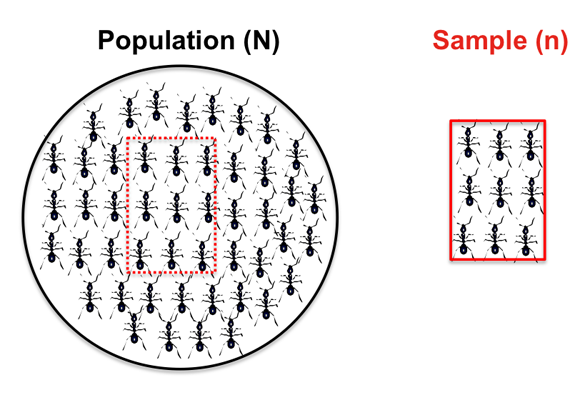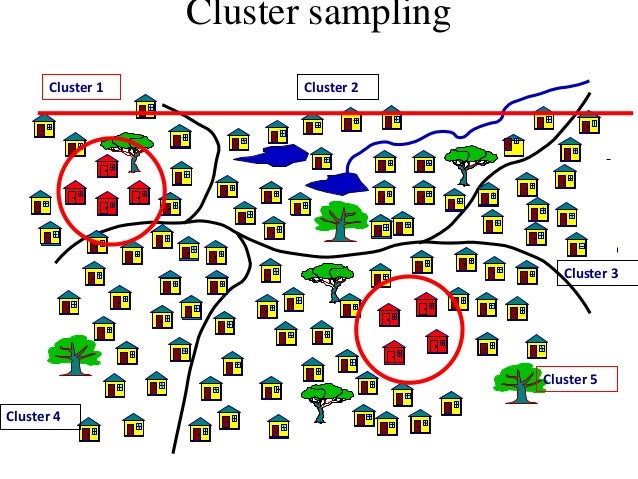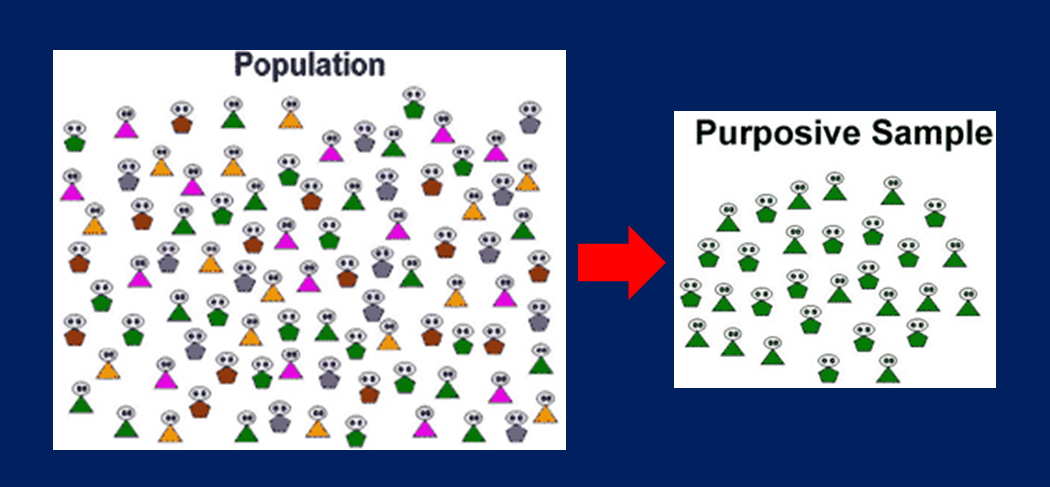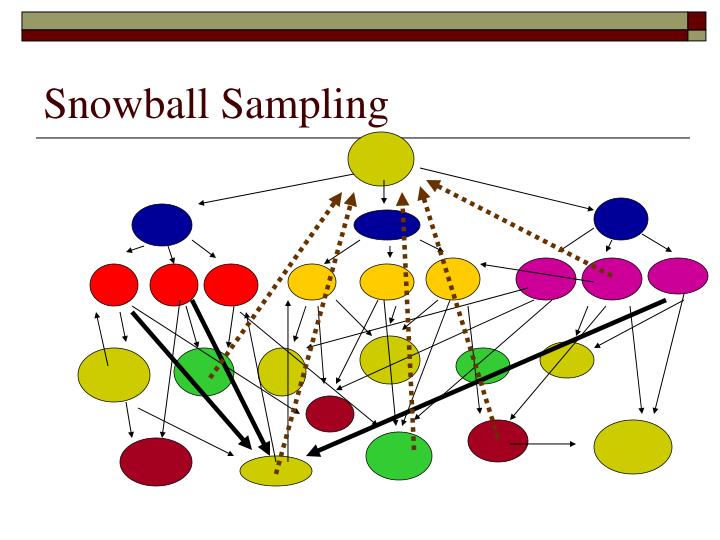Research Sampling
Sampling
Definition- sampling is a statistical process whereby researchers choose the type of the sample.
“The process of using a small number of items or parts of large population to make a conclusion about the whole population”
Population
“A group of elements having similar characteristic it can be human being, living or non-living object. Populations gets as per the study area.
Example- men, women, children elderly adult sports person drunks’ addicts etc.
In simple meaning, a population is a set of units that we are interested in studying. These units should have at least one common characteristic. The units could be people, cases (organizations, institutions), and pieces of data (for example – customer transactions).

Sample-
A sample is a part of the population that is subject to research and used to represent the entire population as a whole. What is crucial here is to study a sample that provides a true picture of the whole group. Often, it’s not possible to contact every member of the population. So, only a sample is studied when conducting statistical or marketing research.
Sampling Bias-
Sampling bias is said to occur if the sample units do not possess the population characteristics. Due to which result may be inaccurate.
The need to sample
- A survey of the entire population is impracticable
- Budget constraints restrict data collection
- Time constraints restrict data collection
- Result from data collection are needed quickly
Characteristics of good sampling-
- The sample must represent the population correctly
- It must be free from bias
- It must possess the least sampling error
- It must be optimum in size
Principle of Sampling
- Selection of sample must be systematic and objective manner
- Sample units must be clearly defined and easily identifiable
- Sample units must be independent of each other
- Same units of sample must be used throughout the study
- The selection process must be on sound criteria
- It should avoid error, bias
There are two basic types of sampling methods-
- Probability sampling
- Non-probability sampling
Probability Sampling
In simple words, probability sampling (also known as random sampling or chance sampling) utilizes random sampling techniques and principles to create a sample. This type of sampling method gives all the members of a population equal chances of being selected.
For example, if we have a population of 100 people, each one of the persons has a chance of 1 out of 100 of being chosen for the sample.
Advantages of probability sampling-
- A comparatively easier method of sampling
- Lesser degree of judgment
- High level of reliability of research findings
- High accuracy of sampling error estimation
- Can be done even by non-technical individuals
- The absence of both systematic and sampling bias.
Disadvantages-
- Monotonous work
- Chances of selecting specific class of samples only
- Higher complexity
- Can be more expensive and time-consuming.
Types of Probability Sampling Methods
- Simple Random Sampling
- Stratified Random Sampling
- Systematic Sampling
- Cluster Random Sampling
- Simple Random Sampling-
Applicable when population is small, homogeneous and readily available.
It is also the most popular way of a selecting a sample because it creates samples that are very highly representative of the population.
All subsets of the frame are given an equal probability. Each element of the frame thus has an equal probability of selection.

Advantage-
- Easy method to use
- No need of prior information of population
- Equal and independent chance of selection to every element.
Disadvantages
- If sampling frame large. this method impracticable.
- Does not represent proportionate representation
Suitability
- This method is suitable for small homogeneous
- Randomly selecting units from a sampling frame. “Random” means mathematically each unit from the sampling frame has an equal probability of being included in the sample.
Replacement of Selected unites-
Sampling schemes may be without replacement or with replacement
For example- if we catch fish measure them and immediately return to the water before continuing with the sample, this is a with replacement design, because we might end up catching and measuring the same fish more than once. However, if we do not return the fish to the water (e.g. if we eat the fish) this becomes a without replacement design.
Applying three Methods-
- Lottery system
- Random number table system-blindfold
- Using the computer
- Using mixing well method
2. Stratified Random Sampling
A stratified random sample is a population sample that involves the division of a population into smaller groups, called ‘strata’. According to some criterion, such as geographic location grade level age or income etc.
Then the researcher randomly selects the final items proportionally from the different strata.
- It is used when the population is heterogeneous
- In this method whole population is divided into small homogeneous group known as strata
- A random sample from each stratum is drawn in proposition to its size.
- The subset of sample is drawn and from the random sample

Advantage-
- Enhancement of representativeness to each sample
- Increased statistical efficiency
- Easy to carry out
Disadvantage-
- The technique is more complex and requires greater efforts than simple random.
- Classification error
- Time consuming and expensive
- Prior knowledge of composition and of distribution of population (complete sampling frame is required)
3. Systematic Sampling
- This method is appropriate if we have a complete list of sampling subjects arranged in some systematic order such as geographical and alphabetical order.
- Similar to simple random sample. No table of random numbers- select directly from sampling frame. Ratio between sample size and population size.
- The process of systematic sampling design generally includes first selecting a starting point in the population and then performing subsequent observations by using a constant interval between samples taken.
- This interval, known as the sampling interval, is calculated by dividing the entire population size by the desired sample size.
Interval between sample units
K=N/n
K-Sample interval
N -population size
n-Sample size
For example- if you as a researcher want to create a systematic sample of 1000 workers at a corporation with a population of 10000, you would choose every 10th individual from the list of all workers.

Advantages-
- Sample easy to select
- Suitable sampling frame can be identified easily
- Sample evenly spread over entire reference population
- Cost effective
Disadvantages-
- Sample may be biased if hidden periodicity in population coincides with that of selection.
- Each element does not get equal chance
- Ignorance of all element between two n element
4. Cluster Random Sampling
This is one of the popular types of sampling methods that randomly select members from a list which is too large.
Cluster sampling is an example of two-stage sampling
- First stage a sample of areas is chosen
- Second stage of respondents within those areas is selected
- Population divided into clusters of homogeneous units, usually based on geographical contiguity
- Sampling unites are group rather than individuals.
- A sample of such cluster id then selected.
Cluster sampling design is used when natural groups occur in a population. The entire population is subdivided into clusters (groups) and random samples are then gathered from each group.

Advantages-
Cut down on the cost of preparing a sampling frame. This can reduce travel and other administrative costs.
Disadvantages-
Sampling error is higher from a simple random sample of same size.
Non-probability Sampling
Non-probability sampling is a group of sampling techniques where the samples are collected in a way that does not give all the units in the population equal chances of being selected. Probability sampling does not involve random selection at all.
Sometime known as grab or opportunity sampling or accidental or haphazard sampling.
This type of sampling is most useful for pilot resting
For example, one member of a population could have a 10% chance of being picked. Another member could have a 50% chance of being picked.
Advantages of non-probability sampling-
- When a respondent refuses to participate, he may be replaced by another individual who wants to give information.
- Less expensive
- Very cost and time effective.
- Easy to use types of sampling methods.
Disadvantages of non-probability sampling-
- The researcher interviews individuals who are easily accessible and available. It means the possibility of gathering valuable data is reduced.
- Do respondents represent the target population.
- Excessive dependence on judgment.
- The researchers can’t calculate margins of error.
- Bias arises when selecting sample units.
- The correctness of data is less certain.
- It focuses on simplicity instead of effectiveness.
Types of Non-Probability Sampling Methods
There are many types of non-probability sampling techniques and designs, but here we will list some of the most popular.
- Convenience Sampling
- Quota Sampling
- Judgment Sampling (Purposive sampling)
- Snowball Sampling
- Convenience Sampling
As the name suggests, this method involves collecting units that are the easiest to access: your local school, the mall, your nearest church and etc. It forms an accidental sample. It is generally known as an unsystematic and careless sampling method.
Respondents are those “who are very easily available for interview”.

For example-
People intercepted on the street, Facebook fans of a brand, Information pools of friends and neighbours “on the street” interviews., etc.
This technique is known as one of the easiest, cheapest, and least time-consuming types of sampling methods.
- Quota Sampling
Quota sampling methodology aims to create a sample where the groups (e.g. males vs. females’ workers) are proportional to the population.
The population is divided into groups (also called strata) and the samples are gathered from each group to meet a quota.

For example-
If your population has 30% female and 70% males, your sample should consist those percentages.
Quota sampling is typically done to ensure the presence of a specific segment of the population.
Advantage-
- Contains specific subgroup in the proportion desired
- May reduce bias
- Easy to manage quick
Disadvantages-
- Dependent on subjective decisions
- Not possible to generalize
- Only reflect population in terms of the quota, possibility of bias in selection no standard error
- Judgment Sampling (Purposive sampling)
- Judgmental sampling is a sampling methodology where the researcher selects the units of the sample based on their knowledge. This type of sampling methods is also famous as purposive sampling or authoritative sampling.
- In this method, units are selected for the sample on the basis of a professional judgment that the units have the required characteristics to be representatives of the population.

Advantage-
Based on the experienced person’s Judgement
Disadvantages-
Cannot measure the representativeness of the sample
- Snowball Sampling
- Useful when a population is hidden or difficult to gain access to the contact with an initial group is used to make contact with others.
- Snowball sampling isn’t one of the common types of sampling methods but still valuable in certain cases.
- It is a methodology where researcher recruits other individuals for the study. This method is used only when the population is very hard-to-reach.
For example- these include populations such as working prostitutes, current heroin users, people with drug addicts, and etc. The key downside of a snowball sample is that it is not very representative of the population.

Advantages-
- Identifying small hard-to reach uniquely defined target population
- Useful in qualitative research
- Access to difficult to reach population
Disadvantages-
- Bias can be present
- Limited generalizability
- Not representative of the population and will result in a biased sample as it is self-selecting